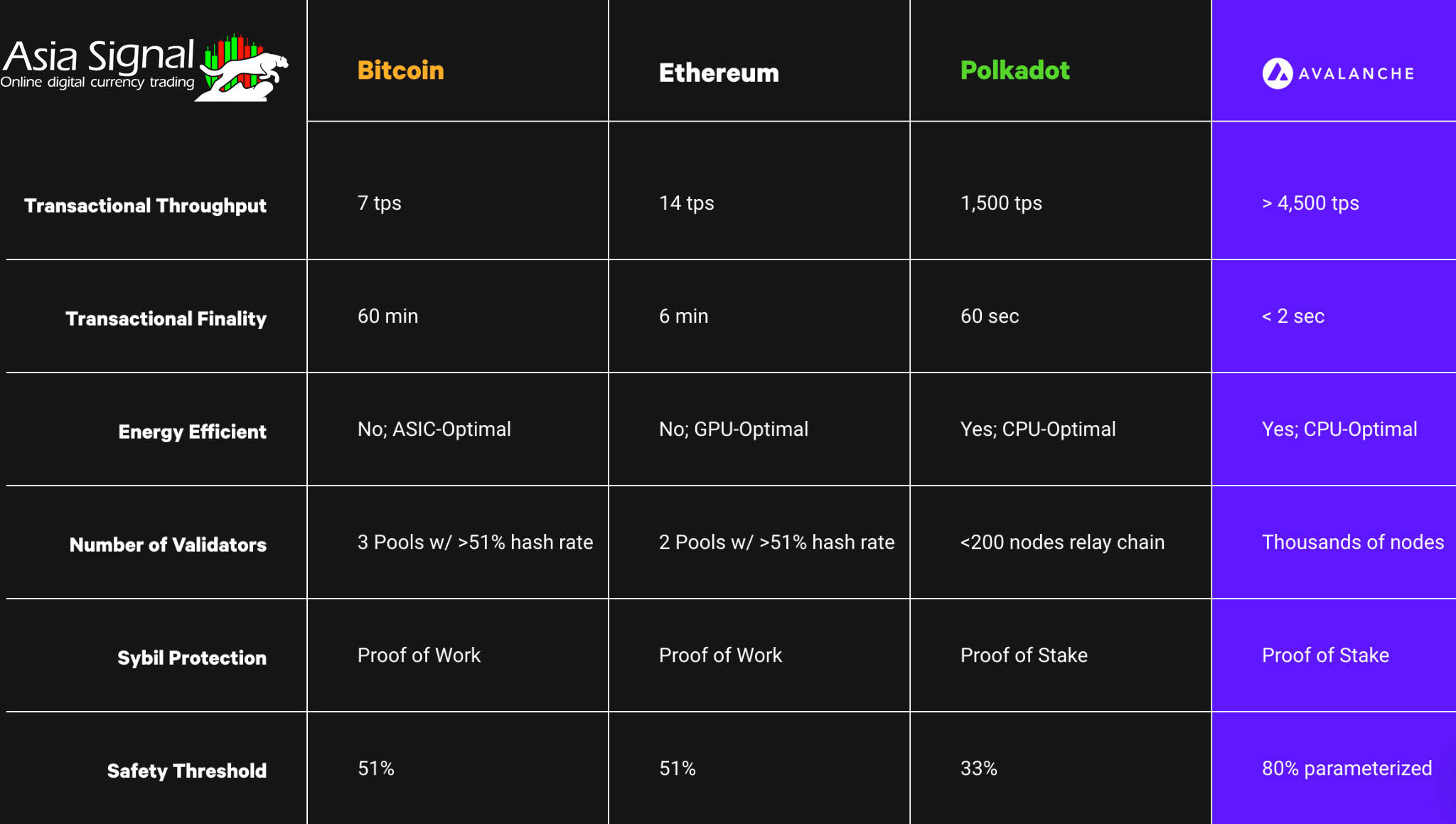Avalanche (AVAX) is a blockchain-based platform with smart contracts that focuses on transaction speed, low pricing, and environmental friendliness. Finally, Avalanche aims to create a highly scalable blockchain that does not compromise on the security or decentralization of the network itself. The Ava Labs team launched Avalanche in 2020; it has risen rapidly in the cryptocurrency rankings.
All you need to know about AVAX

AVAX
Avalanche (AVAX) is a blockchain-based platform with smart contracts that focuses on transaction speed, low pricing, and environmental friendliness. Finally, Avalanche aims to create a highly scalable blockchain that does not compromise on the security or decentralization of the network itself.
The Ava Labs team launched Avalanche in 2020; it has risen rapidly in the cryptocurrency rankings, currently sitting just outside the top ten. Avalanche TVL (Total Value Locked in the Protocol) is also rising and now stands at $3 billion across all Avalanche dapps.
Thanks to its great team, enthusiastic community, and committed backers, Avalanche is a genuine contender in the race to build the world's fastest blockchain.
Everything you need to know about Avalanche, including how it functions and what the AVAX token provides, can be found in this comprehensive guide.
What exactly is Avalanche?

Avalanche
Avalanche's creators and developers, Ava Labs, claim to have created the world's fastest smart contract blockchain platform. Avalanche performs at internet scale for a future when crypto is a global backbone technology using a staggering three separate blockchains.
Until recently, such a goal seemed far-fetched at best, and at worst, a decade away. There is now a thriving community and $230 million ecosystem fund backing the Avalanche mainnet.
In 2019, Dr. Emin Gun Sirer founded Avalanche with the goal of making blockchain transactions complete as quickly as possible. Time to finality is considered as the amount of time it takes for a crypto transaction to complete and be regarded as final and irreversible. Once a transaction reaches "finality," it can never be undone or changed again.
Clearly, finality is a crucial blockchain characteristic (particularly for financial applications), yet the time to finality is not comparable across different blockchains. For example, Ethereum reaches finality in under a minute. In the real world, an avalanche's finality time is near-instantaneous.
Whether or not Avalanche is the world's fastest blockchain is up for debate. A closer look at how this blockchain works and an explanation of how AVAX tokens are staked will help us understand this.
How does Avalanche Work?
.jpg)
How it works
The main innovation of Avalanche is that it uses three blockchains instead of the standard one. Each blockchain in the Avalanche ecosystem focuses on a specific activity instead of having one chain handle all the many functions within the ecosystem.
Decentralization, security, and scalability are all made possible by the Avalanche platform's use of several chains to distribute work.
Exchange Chain (X-Chain)
This is the blockchain that is responsible for creating and exchanging Avalanche assets. Decentralized exchange tokens known as JOE and PNG aren't far behind Avalanche's native AVAX token in terms of popularity.
Fees paid in AVAX are generated through X-Chain transactions. In the same way that Ethereum gas fees are paid in ETH, Fees are always paid in AVAX, even if you're exchanging JOE tokens.
Contract Chain (C-Chain)
Avalanche is best known for its smart contracts. Decentralized apps can be built on Avalanche while taking advantage of the platform's scalability and security features.
For the Avalanche platform, the C-Chain runs smart contracts that are compatible with the EVM (Ethereum Virtual Machine). Anyone can use Avalanche to deploy Ethereum smart contracts because Avalanche is EVM compatible. Just how significant is that? For this reason, existing Ethereum apps, like DeFi's Aave, will be able to quickly and simply migrate to Avalanche.
Developers may use the same Ethereum developer tools to access Avalanche's functionality by deploying smart contracts on Ethereum.
Platform Chain (P-Chain)
Anyone can build an L1 or L2 blockchain from scratch using Avalanche's P-Chain. Creating a group of them is an option as well. The P-Chain serves as the default subnet for all other blockchains in Avalanche.
To manage Avalanche subnets, the P-Chain tracks validators, but subnets must also validate the P-Chain.
Scaling Avalanche requires the use of subnets
We briefly mentioned Avalanche subnets in the P-Chain section above. It's worth going further into their significance, though.
An Avalanche subnet is like Ethereum 2.0 sharding in terms of how it works. A subnet is basically a replica of the platform's primary blockchain (in this instance, Avalanche's Main Network) that is connected to the platform at the beginning.
More importantly, users can construct subnets whenever they choose. To put it in practice: When a subnet's network traffic demands are met or exceeded, another subnet can be launched to free up transactions.
Unlimited subnet creation is what we're getting at (subnets can infinitely create subnets). Compared to Visa, Avalanche's P-Chain has a transaction limit of about 4,500 per second. Despite this, Avalanche does not have a practical TPS limit because of its limitless ability to generate subnets.
Which networks have a comparable subnet-like infrastructure as Avalanche? Here's a little reference chart to help you along the way.

Comparison
AVAX Token
The Avalanche token, or AVAX, serves as the ecosystem's primary means of payment for all transactions. To secure the Avalanche network and reward stakers with extra AVAX, AVAX staking is a vital part of Avalanche's ecosystem.
Using the AVAX deflationary token structure, you can further increase the value you earn by staking your tokens. When transaction fees are paid with AVAX tokens, they are permanently deducted from the total supply of AVAX.
AVAX Staking Rewards
AVAX token owners and holders must be on all subnets, including the primary network. You don’t have to be a validator to benefit from staking AVAX. You can earn a percentage of the staking rewards by delegating your stake to a validator if you wish to receive AVAX staking benefits.
Sixty-four percent of AVAX tokens are now staked. Delegators earn 9.53 percent staking rewards while validators earn slightly under 11 percent annual percentage yield (APY).
Transaction fees can be paid with AVAX
The avalanche is referred to as the ecosystem's common unit of account. AVAX is the network's default money. AVAX is used across all subnets to pay transaction fees, and it is also the currency of choice.
Subnet interoperability can be improved by using AVAX between subnets rather than using their own internal coins.
Tokens and Subnets Can Be Created Using AVAX
The two primary use cases for Avalanche are the development of bespoke coins and establishing blockchain networks (called subnets). For example, developers can use this platform to create NFTs, DeFi protocols, and games.
Custom tokens, smart contracts, and subnet creation on the X-Chain and C-Chain require AVAX fees. It is a subscription-based service with recurring AVAX fees for subnets in particular.
AVAX current price
The current Avalanche price is USD 105.42, with a 24-hour trading volume of USD 896,292,312. As of this writing, the Avalanche has fallen by 0.06% in the last 24 hours. Currently, the market capitalization stands at $26,695,540,659 in US dollars. 243,752,804 AVAX coins are in circulation, with a maximum supply of 243,752,804. It's possible to acquire Avalanche stock on the following exchanges: Binance, OKEx; CoinTiger; FTX; and Huobi Global; these are the most popular. If you are looking for crypto signals for this token and many other tokens, we can help you out.

















Comments